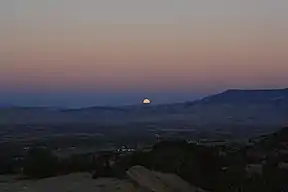Grand Valley (Colorado-Utah)
The Grand Valley[1] is an extended populated valley, approximately 30 miles (48 km) long and 5 miles (8.0 km) wide, located along the Colorado River in Mesa County (and slightly into Garfield County) in western Colorado and Grand County in eastern Utah in the Western United States. The valley contains the city of Grand Junction, as well as other smaller communities such as Fruita and Palisade. The valley is a major fruit-growing region that contains many orchards and vineyards, and is home to one of two designated American Viticultural Areas in Colorado: the Grand Valley AVA. It takes its name from the "Grand River",[2] the historical name of the Colorado River upstream from its confluence with the Green River that was used by locals in the late 19th and early 20th century. The valley is the most densely populated area on the Colorado Western Slope, with Grand Junction serving as an unofficial capital of the region, as a counterpoint to Denver on the eastern slope of the Rocky Mountains in the Colorado Front Range. Interstate 70 and U.S. Highway 6 run through the valley from west-to-east. The Grand Valley is part of the larger Colorado Plateau desert lands.
| Grand Valley | |
|---|---|
 A portion of the Grand Valley at dusk, November 2013 | |
| Geography | |
| Country | United States |
| States | Colorado and Utah |
| County | Mesa County, CO and Grand County, UT |
| Coordinates | 39°11′N 108°43′W |
Description and history
The valley begins where the Colorado River widens at the mouth of De Beque Canyon to the east of Palisade, then follows a wide arc bending to the west. The Colorado receives the Gunnison River, one of its major tributaries, just south of Grand Junction near the midpoint of the valley. The valley is surrounded by large plateau formations, including the Book Cliffs along the north side, the Grand Mesa along the southeast side, and the Uncompahgre Plateau to the southwest. Colorado National Monument sits on a ridge on the southwest side of the valley west of Grand Junction. Much of the surrounding table land areas rimming the valley are public lands controlled by the Bureau of Land Management.

The valley was an area historically occupied by the Ute people (Parianuche band). White settlers began to arrive in the 1880s, farming the valley for a variety of grains and fruits. In the 1890s, it was discovered that sugar beets grown in the valley had a high sugar content, leading to widespread cultivation of that crop. At the turn of the 20th century, evaporation techniques allowed fruit-growers to ship their products more efficiently to distant markets, yielding an expansion of fruit growing in the valley. In 1918, the Government Highline Canal was completed to provide water to cultivate 50,000 acres (20.0 km²) in the valley. The project included a roller dam in De Beque Canyon, the largest of three such dams of this type in the nation.[3]
References
- "Grand Valley". Geographic Names Information System. United States Geological Survey.
- Dawson, John Frank. Place names in Colorado: why 700 communities were so named, 150 of Spanish or Indian origin. Denver: The J. Frank Dawson Publishing Co. p. 25.
- "Grand Junction, Colorado History in Pictures Archived 2005-04-09 at the Wayback Machine".
External links
![]() Media related to Grand Valley (Colorado-Utah) at Wikimedia Commons
Media related to Grand Valley (Colorado-Utah) at Wikimedia Commons

